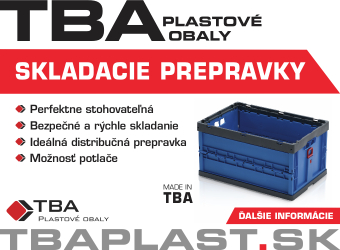Trhové ceny komoditných plastov týždenne
Uvádzame tu trhové ceny rôznych typov komoditných plastov PE-LD, PE-HD, PP a PS v strednej a východnej Európe s oneskorením 5 týždňov. Údaje spracoval náš partner myCEPPI.
Zaujímajú Vás aktuálne ceny komoditných plastov? Objednajte si túto službu Týždenné ceny komoditných plastov u nás v redakcií.
Ceny na týždeň 3/2021
The prices of the “commodity” polymers during the week ahead are affected by the following factors:
- BRENT oil price 56.42 USD/barrel, increasing prices,
- NAPHTHA (European) 503.88 USD/t, sharply rising prices
- EUR/USD: 1.2120, strong Euro
- Contracted monomer pricesin January:
- Ethylene (C2) contract price +65 EUR/t (860 EUR/t)
- Propylene (C3) contract price +65 EUR/t (800 EUR/t),
- Styrene monomer (SM) contract price +108 EUR/t (1,026 EUR/t)
- Polymer capacity news
- Rompetrol LDPE has no planned shutdown until early February
- Basell Orlen is building inventories due to 2 months of spring maintenance, so supply is tight.
- Minor polyolene price increases last week,
- Polymer producers do not accept more orders,
- Very limited supply of all polyolens and ABS,
- Logistics problems are hampering imports from outside Europe, with no signicant shipments expected before the second quarter. Sea freight rates multiplied by 2 or 3.
The last week was characterized by a further increase in polymer prices, with a further price increase of between 60 and 120 €/t for PE and PP. There was no further price increase for orders and contracted quantities conrmed at the beginning of the month. While new orders were accepted by producers at increased prices only. However, most polyolen producers closed their order books in the middle of the week. There are few spot quantities in the markets. While plastics converters are looking for additional sources of supply for fear of further price increases in February. Especially for LDPE. The rapid second weekly price increase shows that this strong demand, which was not typical of early January, is also surprising for polymer producers. The market expectation was that the panic caused by the price increases that began in December would subside during the Christmas holidays. And January starts off as usual, a little slowly and sleepily. However, the fear of rising prices is now making everyone buy. Anyone who didn’t buy during the rst week was not sure to get material during the second week. This vicious circle will also secure the February price rises. Moreover, the fact that buyers of nished plastic products are also afraid of the sudden rise in prices and try to buy in advance has a signicant effect on demand. It is likely that spot prices at the end of January will be contracted prices in February, as was the case for December-January. One of the conditions for further price increases is the increase in the prices of raw materials - monomers and NAPHTHA. The price of NAPHTHA has risen by about 16% since the beginning of the month. It approached the price level in January last year. Another condition for price increases is strong demand, the supply decit. Which is very strongly present in all polyolens and ABS. The big question is how long can prices rise until the end of January. Theoretically, there could be an additional three-digit increase for LDPE and ABS. However, due to the lack of a commodity base, practical price increases take place only for very small quantities, a few hundred tonnes. It may be a refuge for plastics converters to buy off-grade materials, but their prices were already close to those of rst-class materials last week. It could be a further demand shock if “Western Europe” also starts buying again. As the spring season approaches, this is very likely, and this will further strengthen demand and raise polymer prices.
The solution could be to boost imports from outside Europe. Next time, larger shipments of thousands and tons of PE and PP from Russia are expected in February, but this will primarily affect the Baltics and Poland. As the price level rises, it is likely that Middle Eastern materials will also arrive, the prices of which are now still above the European price level. However, in February it can already be competitive. The real solution requires more imports from outside Europe, and that requires the launch of maritime transport.
Polyethylene grades
In the second week of January, LDPE prices were in the range of € 1,220-1,350/t, up € 70-100 over the past week. Bids below 1,200 were still rare at the beginning of the week, but they disappeared by Friday. Regional differences have disappeared. Prices are equally high in all regions. The Serbian LDPE producer and the MOL group also raised prices. The administrative and supply problems due to Brexit have been solved, now more LDPE is coming from Great Britain. However, this does not alleviate the critical shortage. There is virtually no availability on the market, so plastics converters have turned to off-grade and regranulates, as a result, their prices have also risen signicantly. Occasionally there are import offers on the market, Middle Eastern LDPE FILM MFI 0.3 was offered to a Polish trader at a price of around € 1,400/t. This indicates that the equilibrium price, where there is a chance to balance supply and demand, is around € 1,400/t now. This price level is not supported by monomer and NAPHTHA yet.
In the second week of January HDPE prices were in a range of 1,060-1,200 €/t in Central Europe. They rose by 50-80 euros in a week. The typical price range was 1,080-1,150 €/t. The cheapest prices were measured in Serbia. Prices are now rising northwards. The supply is tight, but there is still availability. Polymer producers have recently closed their order books and raised prices. It is expected that only a small quantity will be available at an increased price in the second half of January. Several converters have reported that the Western European HDPE BM / FILM grades introduced in recent years have disappeared from supply or are only available at very high prices. Baltic converters expect SIBUR to import larger quantities of HDPE BM and FILM from Russia in late January, early February, which could expand supply. It can prevent further steep price increases.
Prices by HDPE grades were as follows:
- HDPE BM: 1,060-1,200 €/t,
- HDPE IM: 1,030-1,150 €/t,
- HDPE FILM: 1,080-1,200 €/t
| Grade name | Typical polymer price ranges in the second week of January 2021, Central Europe (€/t) |
| HDPE BM | 1060-1200 |
| HDPE Film | 1080-1200 |
| HDPE IM | 1030-1150 |
| HDPE Pipe (100) | 1180-1250 |
| LDPE Film | 1220-1350 |
| LDPE GP | 1200-1300 |
| LLDPE C4 | 1050-1200 |
| mLLDPE C6 | 1200-1300 |
| PPC | 1150-1290 |
| PPH IM | 1110-1200 |
| PPH IM HMFR | 1150-1250 |
| PPH Raffia | 1110-1190 |
| PPR | 1200-1320 |
| GPPS | 1255-1350 |
| HIPS | 1300-1400 |
| EPS | 1280-1350 |
| ABS | 2150-2600 |
| Typ | Cena |
|---|---|
| HDPE blow molding | 1108 € / t |
| HDPE film | 1128 € / t |
| HDPE injection molding | 1101 € / t |
| HDPE pipe (100) | 1196 € / t |
| LDPE film | 1262 € / t |
| LDPE general purpose | 1267 € / t |
| PP co-polymer injection molding | 1248 € / t |
| PP homo-polymer fiber | 1188 € / t |
| PP homo-polymer injection molding | 1195 € / t |
| PPR | 1278 € / t |
| GPPS | 1310 € / t |
| HIPS | 1351 € / t |
| EPS | 1305 € / t |
myCEPPI - nový prístup v poradenstve a v spravodajstve v oblasti plastov. Poskytneme Vám detailný, aktuálny a na mieru vytvorený obraz o trhu s plastami v strednej a východnej Európe.
Vychádzame z našich osobných a pevných vzťahoch s významnými hráčmi v plastikárskom priemysle v strednej a východnej Európe. Každý mesiac uskutočňujeme stovky osobných a telefonických hovorov so spracovateľmi plastov, distribútormi a výrobcami surovín, zúčastňujeme sa odborných veľtrhov a konferencií.
Informácie, ktoré zhromažďujeme v rámci tohto procesu, tvoria základ našich týždenných cenových reportov komoditných plastov. Obsahujúce taktiež analýzu trhu. Tieto reporty taktiež slúžia ako východiskový bod pre naše ďalšie konzultačné služby ktoré poskytujeme spoločnostiam, ktoré potrebujú pomoc pri vstupe na trh, prípadne pri rozširovaní svojho biznisu, zorientovaní sa v situácií na trhu, atď. Naši odborníci majú desiatky rokov skúseností s plastami.
Radi Vám poskytneme naše služby.
História cien
- 2024:
- 2023:
- 2022:
- 2021:
- 2020:
- 2019:
- 2018:
- 2017:
Najnovšie inzeráty
-
05.03.2024 | ID: 202418726
Top inzerát Spolupráca: Nezaplatené faktúry firmou Industry Storm s.r.o.
19.04.2024 | ID: 202418993
-
18.04.2024 | ID: 202418992
-
18.04.2024 | ID: 202418991
-
18.04.2024 | ID: 202418990
-
17.04.2024 | ID: 202418988
-
17.04.2024 | ID: 202418987
Kúpim: POM drť farebná, biela, natur
17.04.2024 | ID: 202418986
-
16.04.2024 | ID: 202418984
-
17.04.2024 | ID: 202418988
Kúpim: POM drť farebná, biela, natur
17.04.2024 | ID: 202418986
Kúpim: Balíková LDPE fólia ,500 t/mesiac
15.04.2024 | ID: 202418966
Kúpim: Špinavý zvyškový granulát z podláh
15.04.2024 | ID: 202418964
-
11.04.2024 | ID: 202418943
Kúpim: PET odrezky z výroby, tácky, iba transparent
10.04.2024 | ID: 202418939
Kúpim: PA6.6 GF25, TECHNYL A218, originál
09.04.2024 | ID: 202418928
-
09.04.2024 | ID: 202418927
-
09.04.2024 | ID: 202418924
-
05.03.2024 | ID: 202418726
Top inzerát -
18.04.2024 | ID: 202418992
-
18.04.2024 | ID: 202418991
-
18.04.2024 | ID: 202418990
-
17.04.2024 | ID: 202418987
-
16.04.2024 | ID: 202418984
-
15.04.2024 | ID: 202418980
Predám: PP vstrekovací - drť biela
15.04.2024 | ID: 202418979
Predám: Drť EVA Escorene UL00514
15.04.2024 | ID: 202418978
Najbližšie výstavy
22.04.2024 - 26.04.2024 | Hannover
22.04.2024 - 26.04.2024 | Sao Paulo
23.04.2024 - 25.04.2024 | Maastricht
23.04.2024 - 26.04.2024 | Shanghai
23.04.2024 - 26.04.2024 | Wels
23.04.2024 - 25.04.2024 | Varšava
06.05.2024 - 10.05.2024 | Orlando
Saudi Plastics and Petrochem 2024
06.05.2024 - 09.05.2024 | Rijád
06.05.2024 - 09.05.2024 | Stuttgart
15.04.2024
16.04.2024
16.04.2024
17.04.2024
17.04.2024
Školenie - Technológia vstrekovania I.
15.04.2024
Festival personalistov a rozvoja talentov
16.04.2024
17.04.2024
Školenie - Technológia vstrekovania II.
17.04.2024
17.04.2024
Ponuky práce
-
11.04.2024
Plastikár, lepiaci personál - FORM s.r.o.
10.04.2024
Supervisor logistiky, skladu a expedície - KNP s.r.o.
09.04.2024
Skladník - AIS Automotive Interior Systems Slovakia s.r.o.
09.04.2024
Obchodný zástupca / špecialista predaja - Plastcom, spol. s r.o.
04.04.2024
Údržba a obsluha chodu výrobnej linky - Plastcom, spol. s r.o.
04.04.2024
Technik kontroly kvality - ESOX-PLAST s.r.o.
04.04.2024
Majster odborného výcviku - ESOX-PLAST s.r.o.
04.04.2024
Manažér obchodu - Ecocycle s.r.o
25.03.2024
Plastikársky slovník







